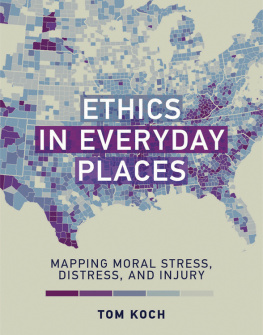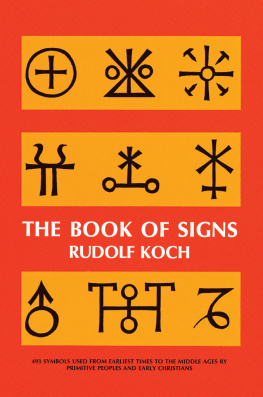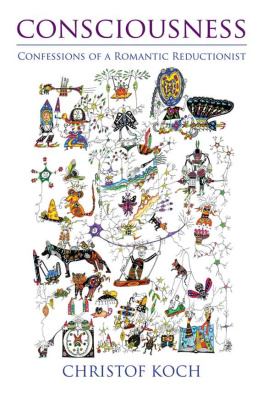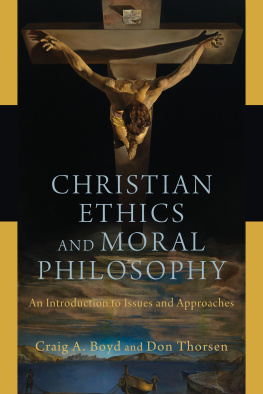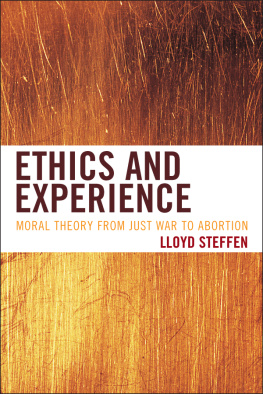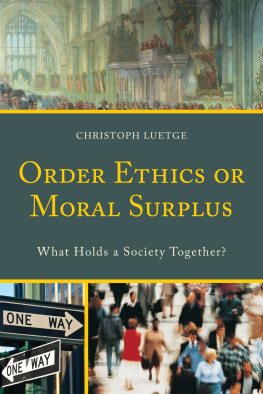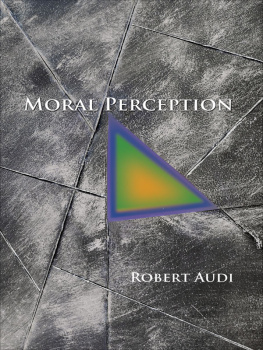Koch - Ethics in Everyday Places: Mapping Moral Stress, Distress, and Injury
Here you can read online Koch - Ethics in Everyday Places: Mapping Moral Stress, Distress, and Injury full text of the book (entire story) in english for free. Download pdf and epub, get meaning, cover and reviews about this ebook. City: Cambridge, year: 2018, publisher: MIT Press, genre: Politics. Description of the work, (preface) as well as reviews are available. Best literature library LitArk.com created for fans of good reading and offers a wide selection of genres:
Romance novel
Science fiction
Adventure
Detective
Science
History
Home and family
Prose
Art
Politics
Computer
Non-fiction
Religion
Business
Children
Humor
Choose a favorite category and find really read worthwhile books. Enjoy immersion in the world of imagination, feel the emotions of the characters or learn something new for yourself, make an fascinating discovery.
Ethics in Everyday Places: Mapping Moral Stress, Distress, and Injury: summary, description and annotation
We offer to read an annotation, description, summary or preface (depends on what the author of the book "Ethics in Everyday Places: Mapping Moral Stress, Distress, and Injury" wrote himself). If you haven't found the necessary information about the book — write in the comments, we will try to find it.
Ethics in Everyday Places: Mapping Moral Stress, Distress, and Injury — read online for free the complete book (whole text) full work
Below is the text of the book, divided by pages. System saving the place of the last page read, allows you to conveniently read the book "Ethics in Everyday Places: Mapping Moral Stress, Distress, and Injury" online for free, without having to search again every time where you left off. Put a bookmark, and you can go to the page where you finished reading at any time.
Font size:
Interval:
Bookmark:

Basic Bioethics
Arthur Caplan, editor
A complete list of the books in the Basic Bioethics series appears at the back of this book.
Tom Koch
Esri Press
Redlands, CA
The MIT Press
Cambridge, Massachusetts
London, England
2017 Tom Koch
Copublished by the MIT Press and Esri Press.
All rights reserved. No part of this book may be reproduced in any form by any electronic or mechanical means (including photocopying, recording, or information storage and retrieval) without permission in writing from the publisher.
This book was set in Stone Serif and Stone Sans by Toppan Best-set Premedia Limited. Printed and bound in the United States of America.
Library of Congress Cataloging-in-Publication Data
Names: Koch, Tom, 1949 author.Title: Ethics in everyday places : mapping moral stress, distress, and injury / Tom Koch.
Description: Cambridge, MA : MIT Press, 2017. | Series: Basic bioethics | Includes bibliographical references and index.
Identifiers: LCCN 2017016888 | ISBN 9780262037211 (hardcover : alk. paper)
eISBN 9780262343893
Subjects: LCSH: Ethics. | CartographyMiscellanea.
Classification: LCC BJ1012 .K55 2017 | DDC 170dc23 LC record available at https://lccn.loc.gov/2017016888
ISBN: 978-0-262-03721-1
ePub Version 1.0
For Margaret Cottle, Ken Hirsh, Harvey Pasternak, and Nancy Withers:
Friends, physicians, and teachers all.
Glenn McGee and I developed the Basic Bioethics series and collaborated as series coeditors from 1998 to 2008. In fall 2008 and spring 2009 the series was reconstituted, with a new Editorial Board, under my sole editorship. I am pleased to present the forty-ninth book in the series.
The Basic Bioethics series makes innovative works in bioethics available to a broad audience and introduces seminal scholarly manuscripts, state-of-the-art reference works, and textbooks. Topics engaged include the philosophy of medicine, advancing genetics and biotechnology, end-of-life care, health and social policy, and the empirical study of biomedical life. Interdisciplinary work is encouraged.
Arthur Caplan
Basic Bioethics Series Editorial Board
Joseph J. Fins
Rosamond Rhodes
Nadia N. Sawicki
Jan Helge Solbakk
This is about that sinking feeling that comes when youve done everything right, played by the rules, and yet know youve done something wrong. It attempts to understand the dilemma that occurs when you seek to do good but find your best intentions stymied. It isnt about simple moral intuitions or making the best possible choice. Rather, it is about those situations in which moral intuitions do not serve because every alternative is bad.
Moral distress is a hot topic these days in moral philosophy and psychology. My work differs from that of most writers in those areas in several immediately obvious ways. First, I reject the assumption that moral stress, distress, and injury are limited largely to members of this or that particular profession. Rather, I argue they are a chronic and pervasive reality in modern Western society. Second, I refuse allegiance to one or another school of moral philosophy and remain constitutionally suspicious of theoretical propositions not grounded in the concrete realities of everyday life. Thus while I do discuss the insights of moral philosophers and ethicists, I build my argument from the ground up, on the experiential basis of normal folk in daily life.
Perhaps most significantly, this investigation relies on maps, which I present as cultural artifacts in which issues of ethics and morality are embedded. Professional cartographers and the works they produce provide an evidentiary backbone in this work not because mapmakers face unique problems but because they do not. The ethical dilemmas they confront, and the questions that maps may raise, are little different in kind from those I have heard from doctors, nurses, and social workers in medicine; graphic artists and reporters; demographers and statisticians; research librarians and others I have sometimes counseled and who, for this project, I have consulted.
The idea of mapping morals is an old one, born in the moral statistics developed in the nineteenth century to analyze public data in the early days of what we today call social science. Almost from the start, those statistics were mapped to present a comprehensible visual argument that focused reams of data bearing on social realities. The first great work in this field was Andr-Michel Guerrys Essay on Moral Statistics (Essai sur la statistique morale de la France, 1833), in which maps distilled and then presented data on a variety of subjects of social concern: charity, illiteracy, illegitimacy, criminal activity, health, poverty, and so on. Maps of incidence in this or that place and at one or another scale powered the search to understand clinical and social phenomena in a manner that might promote specific and what in the day were enlightened responses to them.
I employ that conjunction of morals and social circumstance here in an attempt to image what we mean by ethics, morals, and their traces in our daily lives. As chapter 2 explains, I began with questions raised by professional mapmakers about moral and ethical issues arising in their daily work lives. I quickly realized that their concerns were not specific to mapping but offered general examples of a greater problem. Thus mapping became not the subject but the medium for ethical exploration.
It is in part the sheer ubiquity of the map that recommends it to this kind of study. Maps are everywhere, from the morning newspaper to the evening newscast, embedded in academic journals and lofty tomes on a bewildering range of subjects. Maps proliferate across the World Wide Web. And, as I hope to demonstrate, all come bundled with a series of assumptions and presumptions that make of them not simple, factual presentations but ones whose construction is ethically grounded. As Mary Midgley put it in another context, Facts are not gathered in a vacuum, but to fill gaps in a world-picture which already exists. Mapping pictures a preconceived world within which a set of facts is chosen, organized, analyzed, and then argued.
In the main, historians and philosophers struggle sternly to conceal their own interests and personalities behind a screen of graphs and statistics, vainly hoping that this will make them look as impersonal as physicists. Let me state without apology that this work draws on my personal experiences. It began with questions that I couldnt answer at a meeting of cartographers in 2005. It continues with problems I considered but could not easily resolve. Chapter by chapter, it reviews subjects that have been the focus of my work for more than twenty years. It thus draws on my varying areas of expertise in ethics and bioethics, on the one hand, and on cartography, mapping, journalism and public health, on the other. Since I cannot pretend to Olympian objectivity, let me instead use this foreword to introduce myself, as well as the chapter-by-chapter program that resulted. There is nothing wrong with honest bias as long as it is clearly stated.
I am a US citizen by birth and a Canadian citizen by choice. My worldview, and that of this work, is therefore fundamentally North American. I make no general claims for the universality of its conclusions, although I believe that the materials presented, chapter by chapter, reflect more than a parochial perspective. Although I have studied, translated, and worked in other languages (Chinese, Spanish, and Japanese), English remains my primary working language. Thus the references at the back of the book are primarily to English-language works.
Next pageFont size:
Interval:
Bookmark:
Similar books «Ethics in Everyday Places: Mapping Moral Stress, Distress, and Injury»
Look at similar books to Ethics in Everyday Places: Mapping Moral Stress, Distress, and Injury. We have selected literature similar in name and meaning in the hope of providing readers with more options to find new, interesting, not yet read works.
Discussion, reviews of the book Ethics in Everyday Places: Mapping Moral Stress, Distress, and Injury and just readers' own opinions. Leave your comments, write what you think about the work, its meaning or the main characters. Specify what exactly you liked and what you didn't like, and why you think so.

